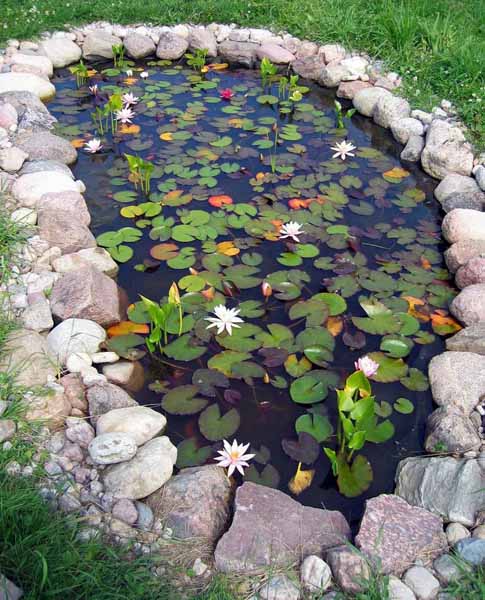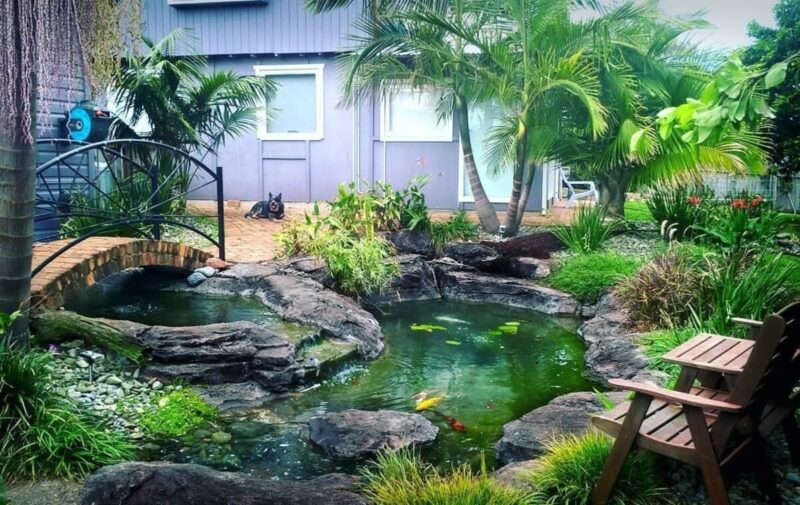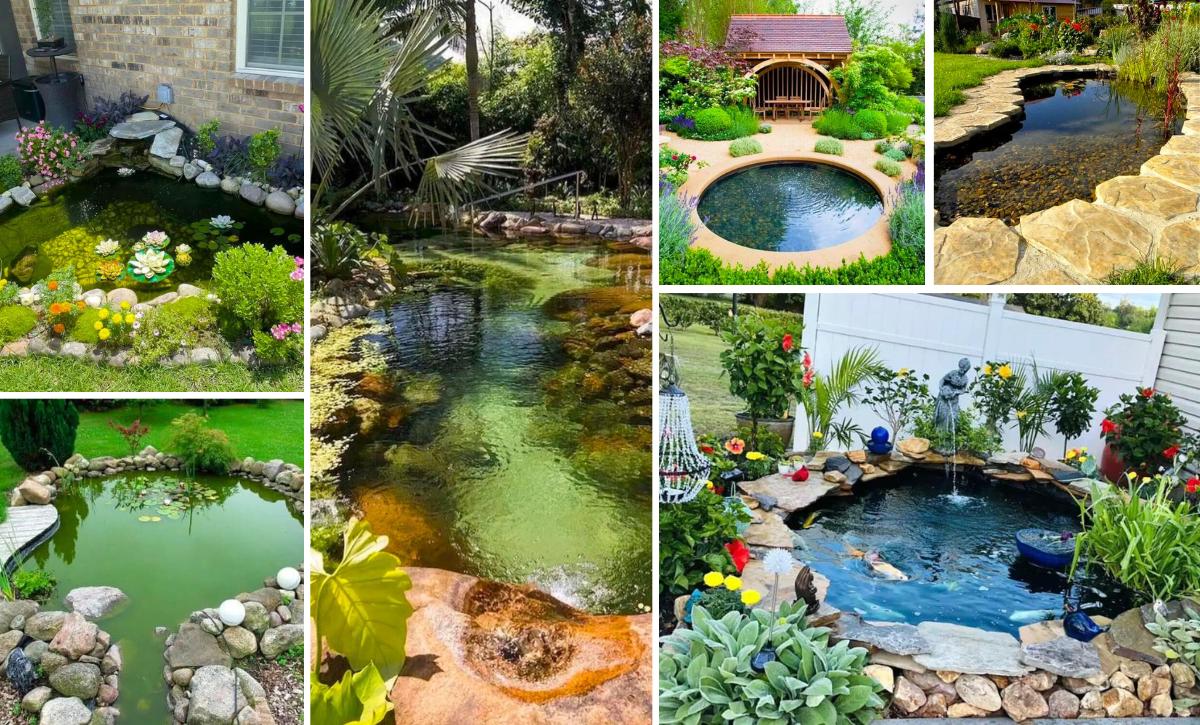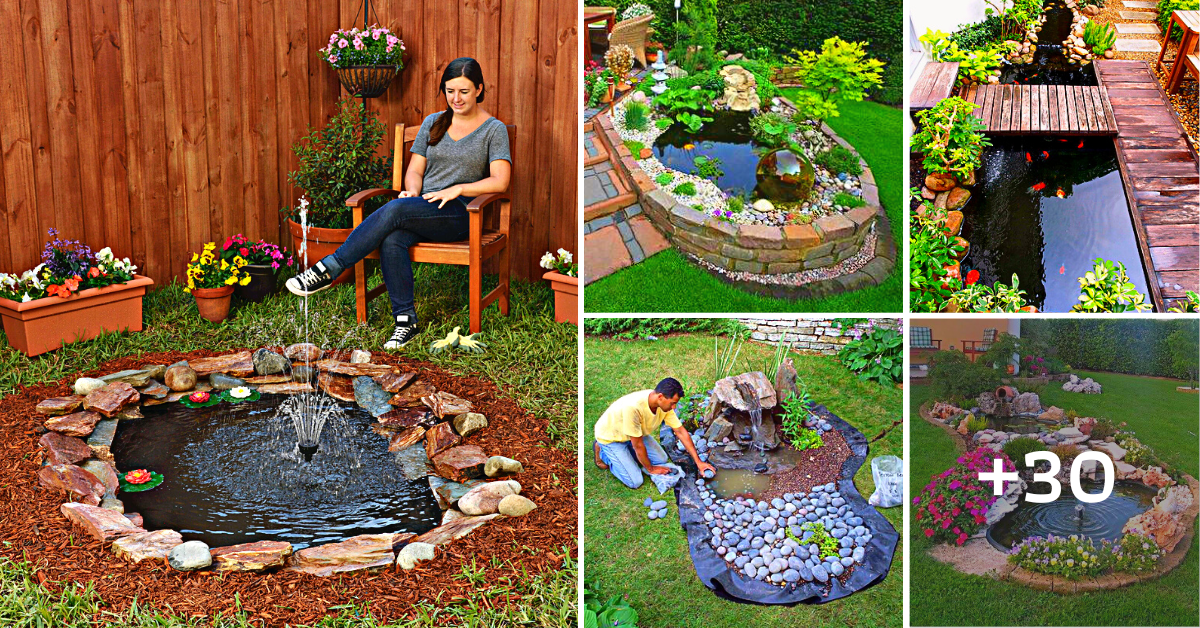Tiny Backyard Pond Paradise: DIY Dreams!
Tiny Backyard Pond Paradise: DIY Dreams!
Transforming a small space into a tranquil oasis is entirely achievable, even if that space is your backyard. Creating a tiny backyard pond isn't just about aesthetics; it's about bringing nature's serenity into your daily life. This comprehensive guide will walk you through the process of designing, building, and maintaining your own miniature aquatic paradise, turning your DIY dreams into a shimmering reality.
Part 1: Planning Your Tiny Pond Paradise
Before you even pick up a shovel, meticulous planning is key to a successful project. Failing to plan is planning to fail, especially when dealing with water features. Here's a breakdown of the essential planning stages:
1. Assessing Your Space:
The first step involves a realistic assessment of your available space. Measure the area carefully, considering not only the pond itself but also the surrounding landscaping. A tiny pond doesn't mean cramped. Think about the overall aesthetic you want to achieve. Do you envision a secluded, intimate space, or a more open and integrated feature? Consider the following:
- Size: How much space can you realistically dedicate to the pond and its surrounding features? Even a small pond requires adequate space for proper filtration and maintenance. A 3ft x 3ft pond is a great starting point for beginners.
- Sunlight: How much direct sunlight does your chosen area receive? Excessive sunlight can lead to algae blooms, while insufficient sunlight can hinder plant growth. Aim for a balance – perhaps a few hours of morning sun and some afternoon shade.
- Access: Consider accessibility for maintenance and cleaning. Will you need to reach all parts of the pond easily?
- Surrounding Landscape: What is the existing landscape like? Will you need to remove existing plants or features? How will the pond integrate with the rest of your backyard?
- Utilities: Check for underground utilities (gas lines, electrical cables) before digging. Contact your local utility companies to ensure your safety.
2. Choosing Your Pond Style:
Once you've assessed your space, you can begin thinking about the style of your pond. Tiny backyard ponds come in various shapes and styles:
- Formal Ponds: These ponds are characterized by clean lines and geometric shapes, often featuring straight edges and symmetrical designs. They create a structured and sophisticated look, ideal for modern or minimalist gardens.
- Informal Ponds: Informal ponds have natural, irregular shapes, mimicking the curves and contours found in natural water bodies. They create a more relaxed and organic feel, blending seamlessly with the surrounding landscape.
- Pre-formed Ponds: Pre-formed ponds are available in various sizes and shapes, offering a convenient and easy-to-install option. They are typically made of durable plastic or resin and are ideal for beginners.
- DIY Liner Ponds: For a more customizable approach, you can construct a pond using a flexible liner, allowing for more creative freedom in shaping your pond.
3. Selecting Your Materials:
Material selection significantly impacts the longevity and aesthetics of your pond. Consider these options:
- Pond Liner: Rubber or EPDM liners are durable, long-lasting, and resistant to punctures. PVC liners are cheaper but less durable. Choose a liner that's appropriate for your pond's size and depth.
- Rocks and Stones: Natural stones can be used to create a natural look and edge for your pond. Choose stones that are appropriate for your chosen style and landscaping.
- Plants: Aquatic plants are crucial for maintaining a healthy pond ecosystem. They help to filter the water, oxygenate it, and provide habitat for beneficial microorganisms. Research plants suitable for your climate and the amount of sunlight your pond receives.
- Pump and Filter: A small, submersible pump and filter system are essential for maintaining water quality in your pond. Choose a system appropriate for the size of your pond.
Part 2: Building Your Tiny Pond
With your plans finalized, it's time to get your hands dirty. Here’s a step-by-step guide to building your DIY backyard pond:
1. Excavation:
Carefully excavate the area according to your chosen pond design. Ensure the hole is slightly larger than your planned pond size to allow for the liner's overlap. The depth should be sufficient for your chosen plants and any desired features, such as waterfalls or cascades (if applicable).
2. Liner Installation:
Lay the pond liner into the excavated hole, ensuring it's smooth and wrinkle-free. Overlap the edges to allow for sufficient coverage and secure the liner with stones or rocks around the perimeter.
3. Adding Water:

Gradually fill the pond with water, allowing the liner to settle naturally. Check for any leaks or punctures. If necessary, make the necessary repairs before proceeding.
4. Installing Pump and Filter:
Position the pump and filter system in the pond according to the manufacturer's instructions. Ensure the pump is submerged and the filter is properly connected. Consider the placement of the filter carefully to avoid disrupting the aesthetic appeal of your pond.

5. Planting and Landscaping:
Plant your chosen aquatic plants, making sure they are appropriately spaced and positioned for optimal growth. Add rocks and stones to create a visually appealing edge and to camouflage the liner. Consider adding features such as stepping stones or small waterfalls for enhanced visual appeal.
6. Finishing Touches:

Add any finishing touches, such as decorative ornaments or lighting. Remember, less is often more when it comes to decorating a small pond. Overcrowding can detract from the serene atmosphere.
Part 3: Maintaining Your Tiny Pond Paradise
Maintaining your tiny backyard pond requires regular attention to keep it healthy and beautiful. Here's a routine maintenance schedule:

1. Water Level Check:
Regularly check the water level and top it up as needed due to evaporation, especially during hot weather.
2. Cleaning:

Regularly remove debris and leaves from the pond's surface using a net or skimmer.
3. Algae Control:
Algae growth is common in ponds. Maintain good water quality through regular filtration and consider using appropriate algaecides if necessary. Over-fertilization can contribute to algae blooms. Ensure you are using the correct dosage for your pond size.

4. Plant Maintenance:
Regularly trim and maintain your aquatic plants to prevent overcrowding and maintain a balanced ecosystem. Remove any dead or decaying plants.
5. Filter Maintenance:

Clean or replace your pond filter according to the manufacturer's instructions. A clogged filter can negatively impact water quality.
6. Water Testing:
Periodically test your pond water to monitor its pH levels and ensure it's within the optimal range for aquatic life. Kits are readily available at most garden centers.

7. Winter Preparations (If Applicable):
In colder climates, take steps to protect your pond during winter. This might involve removing some water, adding a pond de-icer, or covering the pond to insulate it.
Part 4: Troubleshooting Common Problems

Even with meticulous planning and maintenance, problems can arise. Here are some common issues and their solutions:
- Algae Blooms: Excessive sunlight, nutrient buildup (from fertilizers or decaying organic matter), and poor water circulation can all contribute to algae blooms. Increase water circulation, remove excess nutrients, and consider using an algaecide as a last resort.
- Cloudy Water: Cloudy water often indicates a problem with the filtration system or an excess of organic matter. Check your filter, clean it if necessary, and remove any excess debris.
- Fish Diseases: If you have fish, watch for signs of disease and consult a veterinarian if necessary. Maintaining good water quality is crucial for preventing fish diseases.
- Leaks: If you notice a significant drop in the water level, check for leaks in the liner or any other part of the pond. Patch any leaks promptly using a suitable repair kit.
- Overgrowth of Plants: Overgrowth of plants can crowd the pond, hindering water circulation and causing aesthetic issues. Regular pruning and thinning are essential.
Conclusion: Your Tiny Pond Awaits

Creating a tiny backyard pond is a rewarding experience. It allows you to bring a touch of nature's beauty into your living space, fostering a calm and serene environment. By following this detailed guide, you'll be well-equipped to turn your DIY dreams into a stunning and functional backyard oasis. Remember to enjoy the process, learn from any challenges you encounter, and admire the beauty of your handmade pond paradise. The gentle sounds of water, the vibrant colors of aquatic plants, and the peaceful ambiance are all well worth the effort. So get started and begin planning your personal piece of aquatic heaven!
Tiny Pond, HUGE Backyard Impact!
Transforming your backyard into a tranquil oasis doesn't require a sprawling landscape or a hefty budget. A tiny pond, meticulously planned and executed, can deliver a surprisingly significant impact, adding beauty, serenity, and even biodiversity to your outdoor space. This comprehensive guide will explore the possibilities, the practicalities, and the potential pitfalls of creating a miniature aquatic haven in your own backyard.
Planning Your Perfect Mini-Pond: Size Matters, but So Does Style
Before diving into the details of construction, it's crucial to carefully plan your tiny pond's design and location. The "tiny" aspect offers flexibility, allowing you to adapt the design to your available space and personal aesthetic. However, even small ponds require thoughtful consideration.
1. Choosing the Right Spot: Sun, Shade, and Accessibility
The location of your pond will significantly impact its success and longevity. Consider the following:
- Sunlight: Most aquatic plants thrive with at least four to six hours of sunlight per day. However, excessive direct sunlight can lead to excessive algae growth. A balance is key. Experiment with different locations to gauge the sunlight exposure throughout the day.
- Shade: Strategically placed trees or shrubs can provide welcome shade during the hottest parts of the day, reducing the risk of overheating and algae blooms.
- Accessibility: Think about ease of maintenance. Choose a location that allows for convenient access for cleaning, planting, and monitoring your pond. Consider proximity to a water source for filling and potential drainage solutions.
- Proximity to Structures: Avoid placing your pond too close to foundations or other structures, as fluctuating water levels can cause damage.
2. Size and Shape: Miniature Marvels
The beauty of a tiny pond lies in its adaptability. A small pond can be as simple as a pre-formed plastic liner or as elaborate as a custom-built, multi-tiered creation. Consider these factors when determining size and shape:

- Space Available: Your available space will dictate the maximum size of your pond. Even a small area can accommodate a charming miniature pond.
- Shape and Style: Choose a shape that complements your existing landscape design. Round, square, oval, or irregular shapes all have their unique charm. Consider incorporating natural-looking curves for a more organic feel.
- Depth: Even small ponds benefit from varying depths. Shallower areas are ideal for marginal plants, while deeper areas provide habitat for aquatic animals. Aim for at least 12-18 inches of depth in the deepest part of your pond.
3. Essential Elements: Plants, Water Features, and More
To truly make your tiny pond shine, consider incorporating these elements:

- Aquatic Plants: Plants are crucial for a healthy pond ecosystem. They provide oxygen, filter the water, and add visual interest. Choose a variety of oxygenating plants (like hornwort or anacharis), marginal plants (like irises or reeds), and floating plants (like water lilies or duckweed) to create a vibrant and balanced environment. Be mindful of the space required for each plant to grow.
- Water Features: A small fountain or bubbler adds visual appeal and helps to oxygenate the water. The gentle sound of water can also create a calming atmosphere. Choose a feature appropriate for the scale of your pond.
- Rocks and Stones: Natural-looking rocks and stones can be used to create a more natural aesthetic, provide hiding places for aquatic life, and help to stabilize the pond liner or structure.
- Submerged Structures: Consider adding small, safe hiding places for aquatic animals such as frogs or newts using pottery or rocks.
Construction Techniques: From Kits to Custom Builds
Creating your tiny pond can range from a simple DIY project to a more complex undertaking. Several methods are available, each with its advantages and disadvantages:

1. Pre-formed Pond Liners: The Easy Option
Pre-formed pond liners are a convenient and relatively inexpensive option for creating a tiny pond. These are typically made of durable plastic and come in various shapes and sizes. Installation is relatively straightforward, requiring minimal digging and expertise. However, they are less flexible in terms of customization and may not offer the same aesthetic appeal as custom-built ponds.
2. Flexible Pond Liners: More Customizable

Flexible pond liners, usually made from EPDM rubber or butyl rubber, offer more flexibility in terms of shape and size. They can be adapted to almost any shape or contour, allowing for a more natural-looking pond. Installation requires more digging and careful preparation, but the result is a more bespoke and often longer-lasting pond. Ensure you choose a liner with a suitable thickness and UV resistance for optimal durability.
3. Custom-Built Ponds: A Work of Art
For the ambitious gardener, a custom-built pond offers the ultimate level of control and customization. This involves carefully digging the pond shape, creating appropriate layers (e.g., gravel, sand, liner), and installing any water features. It requires more time, effort, and potential expense, but the result can be a truly stunning and personalized feature in your backyard.

Maintaining Your Miniature Oasis: A Year-Round Commitment
A tiny pond, while visually appealing, requires regular maintenance to remain healthy and thriving. Here’s a guide to year-round care:
1. Spring Cleaning: Getting Your Pond Ready

Spring is the perfect time for a thorough clean-up. Remove any debris that has accumulated over the winter, trim back overgrown plants, and top up the water level. Consider using a pond vacuum to remove sediment from the bottom.
2. Summer Monitoring: Algae and Temperature Control
Summer can bring challenges, such as algae growth and temperature fluctuations. Regular monitoring is essential. Ensure adequate shade to control temperature and consider using natural algaecides or beneficial bacteria to manage algae blooms.

3. Autumn Preparations: Protecting Your Pond
As autumn arrives, prepare your pond for winter. Remove any decaying plant matter to prevent it from decomposing and depleting oxygen levels during the colder months. Depending on your climate, you may need to take additional steps to protect the pond from freezing.
4. Winter Care: Minimal Intervention

Winter usually requires minimal intervention, though it’s advisable to keep an eye on the pond's ice cover to ensure that it doesn’t become too thick, potentially suffocating aquatic life. Avoid disturbing the pond excessively during winter.
Beyond the Beauty: Ecological Benefits of a Tiny Pond
Creating a tiny pond is not just about aesthetics; it’s about enhancing the biodiversity of your backyard. A healthy pond can attract a variety of wildlife, including:

- Amphibians: Frogs, toads, and newts will find a home in your pond, providing natural pest control and adding a unique element to your backyard ecosystem.
- Insects: Dragonflies, damselflies, and other beneficial insects will be drawn to the water, adding to the biodiversity and helping control pest populations.
- Birds: Birds will visit your pond for drinking and bathing, adding a vibrant soundtrack to your outdoor space.
By incorporating diverse planting and creating suitable habitats, you can significantly increase the ecological value of your backyard.
Conclusion: A Tiny Investment, a Big Reward

Creating a tiny pond in your backyard is a rewarding project that offers significant aesthetic, ecological, and personal benefits. While it requires careful planning and ongoing maintenance, the tranquil beauty and increased biodiversity it provides far outweigh the effort involved. From the simple pleasures of listening to the gentle sound of water to the excitement of watching dragonflies dance above the surface, a miniature pond can truly transform your backyard into a personal haven. So, take the plunge—you might be surprised by the huge impact a tiny pond can have.


